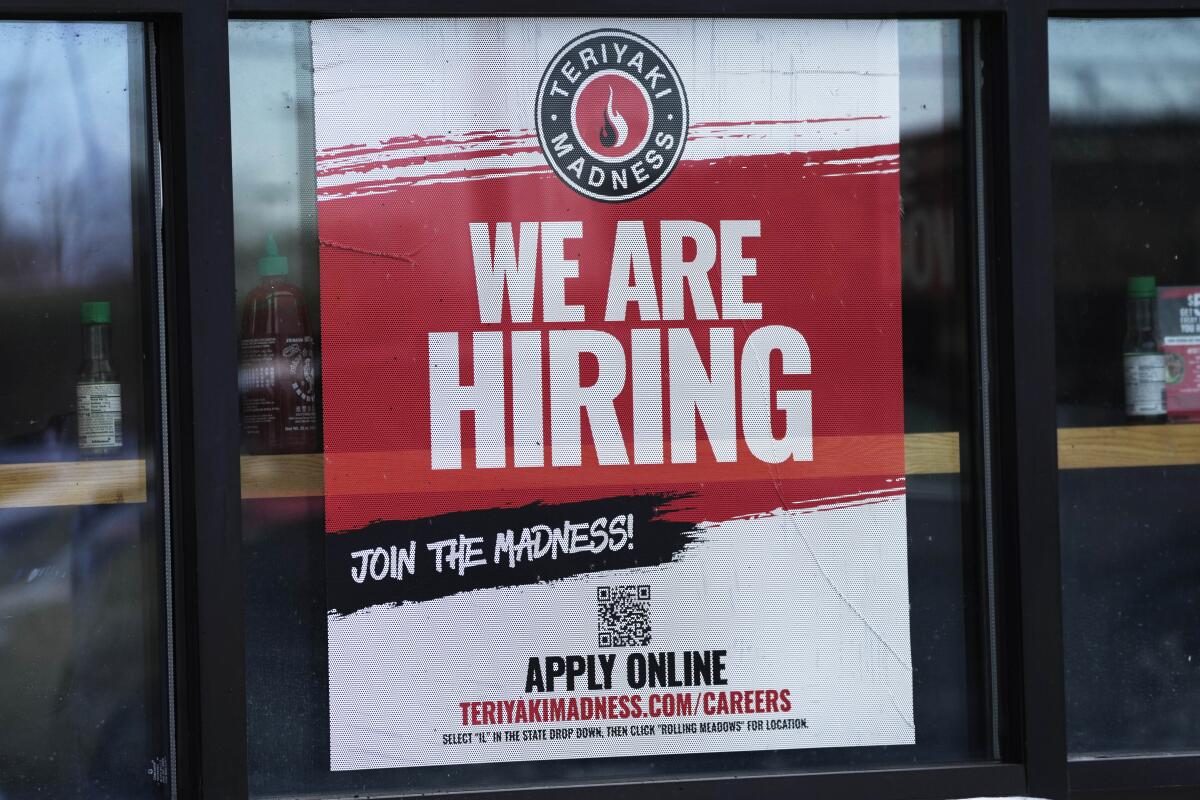U.S. adds a surprisingly strong 517,000 jobs despite Fed hikes

- Share via
WASHINGTON — America’s employers added a sizzling 517,000 jobs in January, a surprisingly strong gain in the face of the Federal Reserve’s aggressive drive to slow growth and tame inflation with higher interest rates.
The unemployment rate dipped to 3.4%, the lowest level since 1969.
Friday’s government report added to the picture of a resilient labor market, with low unemployment, relatively few layoffs and many job openings even as most economists foresee a recession nearing. Though good for workers, employers’ steady demand for labor has also helped accelerate wage growth and contributed to high inflation.
But the Fed’s inflation watchers might be reassured somewhat by January’s wage data: Average hourly pay rose 4.4% last month from a year earlier, slower than the 4.8% year-over-year increase in December. And from December to January, wages rose 0.3%, below the 0.4% increase the previous month.
On top of the sizzling job growth it reported for January, the government on Friday also revised up its estimate of employment gains in November and December by a combined 71,000.
January’s gains were broad-based across industries. A category that includes restaurants and bars added 99,000 jobs. Professional and business services jobs, including bookkeepers and consultants, rose by 82,000.
Governments added 74,000, boosted by the end of a worker strike against California’s state university system. Healthcare added 58,000 jobs, retailers 30,000. Construction gained 25,000 jobs. Manufacturing added 19,000.
Economists, who had collectively estimated that the economy added just 185,000 jobs last month, were caught off-guard by the size of the gains.
“This is a labor market on heat,’’ said Seema Shah, chief global strategist at Principal Asset Management. It would be difficult, she suggested, “to see the Fed stop raising rates and entertain ideas of rate cuts when there is such explosive economic news coming in.”
The proportion of adults who either had a job or were looking for one — the so-called labor force participation rate — stayed at 62.4%, well below pre-pandemic levels.
January’s job growth far exceeded December’s 260,000 total and extended a streak of powerful hiring gains that raised concerns at the Fed about inflation pressures. The Fed has raised its key rate eight times since March to try to contain inflation, which hit a four-decade high last year but has slowed since then.
Companies are still seeking more workers and are hanging tightly onto the ones they have. Putting aside some high-profile layoffs at big tech companies like Microsoft, Google, Amazon and others, most workers are enjoying an unusual level of job security even at a time when many economists foresee a recession approaching.
For all of 2022, the economy had added a sizzling average of 375,000 jobs a month. That was a pace vigorous enough to have contributed to the painful inflation Americans have endured, the worst such bout in 40 years. A tight job market tends to put upward pressure on wages, which, in turn, feed into inflation.
The Fed, hoping to cool the job market and the economy — and, as a consequence, inflation — has steadily raised borrowing rates, most recently on Wednesday. Year-over-year measures of consumer inflation have steadily eased since peaking at 9.1% in June. But at 6.5% in December, inflation remains far above the Fed’s 2% target, which is why the central bank’s policymakers have reiterated their intent to keep raising borrowing rates for at least a few more months.
The Fed is aiming to achieve a “soft landing” — a pullback in the economy that is just enough to tame high inflation without triggering a recession. The policymakers hope that employers can slow wage increases and inflationary pressures by reducing job openings but not necessarily by laying off many employees.
But the job market’s resilience isn’t making that hoped-for outcome any easier. On Wednesday, the Labor Department reported that employers posted 11 million job openings in December, an unexpected jump from 10.4 million in November and the largest number since July. There are now about two job vacancies, on average, for every unemployed American.
The Labor Department’s monthly count of layoffs has amounted to fewer than 1.5 million for 21 straight months. Until 2021, that figure had never dropped so low in records dating back two decades.
Yet another sign that workers are benefiting from unusual job security is the weekly number of people who apply for unemployment benefits. That figure is a proxy for layoffs, one that economists monitor for clues about where the job market might be headed. The government said Thursday that the number of jobless claims fell last week to its lowest level since April.
The pace of applications for unemployment aid has remained rock-bottom despite a steady stream of headline-making layoff announcements. Facebook parent Meta is cutting 11,000 jobs, Amazon 18,000, Microsoft 10,000, Google 12,000. Some economists suspect that many laid-off workers might not be showing up at the unemployment line because they can still find new jobs easily.
More to Read
Inside the business of entertainment
The Wide Shot brings you news, analysis and insights on everything from streaming wars to production — and what it all means for the future.
You may occasionally receive promotional content from the Los Angeles Times.










